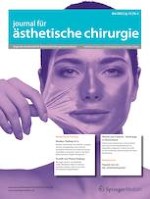Erschienen in:

20.04.2022 | Pflege | Leitthema
Prä- und postinterventionelle Hautpflege bei Laser- und Peelingbehandlungen
verfasst von:
Dr. med. F. Pahnke, Dr. med. M. Peckruhn, Prof. Dr. med. habil. P. Elsner
Erschienen in:
Journal für Ästhetische Chirurgie
|
Ausgabe 2/2022
Einloggen, um Zugang zu erhalten
Zusammenfassung
Zur Behandlung von Zeichen der Hautalterung und beispielsweise Aknenarben werden chemische Peelings und ablative Laserverfahren weltweit zunehmend eingesetzt. Sie werden den ästhetisch-chirurgischen Verfahren häufig aufgrund der geringeren Invasivität vorgezogen. Beide Verfahren beruhen auf dem Prinzip der kontrollierten Schädigung der Haut. Die anschließende Regeneration soll zur Bildung neuen epidermalen (und ggf. dermalen) Gewebes führen und so zu einem ästhetisch optimierten Hautbild beitragen. Aktuell fehlt es in Deutschland an expliziten Empfehlungen bzw. Leitlinien zur topischen Therapie bei diesen Verfahren; die Vor- und Nachbehandlung unterliegt den individuellen Einschätzungen und Erfahrungen des Behandlers. Es ist Konsens, dass ein adäquates Vor- und Nachbehandlungsregime zur Verbesserung des Outcomes sowie zur Verringerung der Downtime beiträgt, sodass im Beitrag verschiedene Möglichkeiten der Vor- und Nachbehandlung vorgestellt werden. Das Priming umfasst in den meisten Fällen intensiven UV-Schutz, topische Retinoide und hautaufhellende Agenzien sowie mitunter eine orale Herpesprophylaxe. Um die postinterventionelle Wundheilung zu unterstützen, sollte die Hautpflege einerseits auf der Modulation der Inflammation und andererseits auf einer adäquaten Feuchtigkeitsbalance der Haut aufgebaut sein. Neben leichten Feuchtigkeitslotionen sind Breitspektrum-UV-Schutz sowie das Vermeiden von Sport und Schwitzen dabei essenziell.